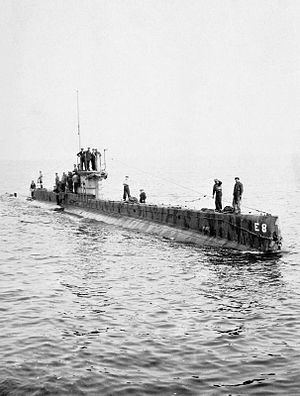Name HMS E8 Laid down 30 March 1912 Fate Scuttled, 4 April 1918 Length 54 m Beam 4.7 m | Cost £105,700 Commissioned 18 June 1914 Construction started 30 March 1912 | |
 | ||
HMS E8 was a British E-class submarine built at Chatham Dockyard. She was laid down on 30 March 1912 and was commissioned on 18 June 1914. She cost £105,700. During World War I she was part of the British submarine flotilla in the Baltic.
Contents
Design
The early British E-class submarines, from E1 to E8, had a displacement of 652 tonnes (719 short tons) at the surface and 795 tonnes (876 short tons) while submerged. They had a length overall of 180 feet (55 m) and a beam of 22 feet 8.5 inches (6.922 m), and were powered by two 800 horsepower (600 kW) Vickers eight-cylinder two-stroke diesel engines and two 420 horsepower (310 kW) electric motors. The class had a maximum surface speed of 16 knots (30 km/h; 18 mph) and a submerged speed of 10 knots (19 km/h; 12 mph), with a fuel capacity of 50 tonnes (55 short tons) of diesel affording a range of 3,225 miles (5,190 km; 2,802 nmi) when travelling at 10 knots (19 km/h; 12 mph), while submerged they had a range of 85 miles (137 km; 74 nmi) at 5 knots (9.3 km/h; 5.8 mph).
The 'Group 1' E class boats were armed with four 18 inches (460 mm) torpedo tubes, one in the bow, one either side amidships, and one in the stern; a total of eight torpedoes were carried. Group 1 boats were not fitted with a deck gun during construction, but those involved in the Dardanelles campaign had guns mounted forward of the conning tower while at Malta Dockyard.
E-Class submarines had wireless systems with 1 kilowatt (1.3 hp) power ratings; in some submarines, these were later upgraded to 3 kilowatts (4.0 hp) systems by removing a midship torpedo tube. Their maximum design depth was 100 feet (30 m) although in service some reached depths of below 200 feet (61 m).
Crew
Her complement was three officers and 28 men.
Service history
On 5 August 1914, she was towed by the destroyer Ariel to Terschelling along with E6 which was towed by the destroyer Amethyst. E6 and E8 then made the first Heligoland Bight patrol.
On 23 October 1915, she sank the 9,050 ton, 3 funnel armoured cruiser SMS Prinz Adalbert 20 nautical miles (37 km) west of Libau. As the result of this action the submarine's commander, Commander Francis Goodhart, was awarded the Cross of St. George by Tsar Nicholas II. During her time in the Baltic Aksel Berg, who later became the founder of Soviet cybernetics, was her liaison officer.
Fate
E8 met her fate on 4 April 1918 outside Helsinki 1.5 nautical miles (2.8 km) off Harmaja Light, Gulf of Finland. She was scuttled by her crew, along with E1, E9, E19, C26, C27, and C35 to avoid seizure by advancing German forces who had landed nearby.
She was salvaged in August 1953 for breaking in Finland.
